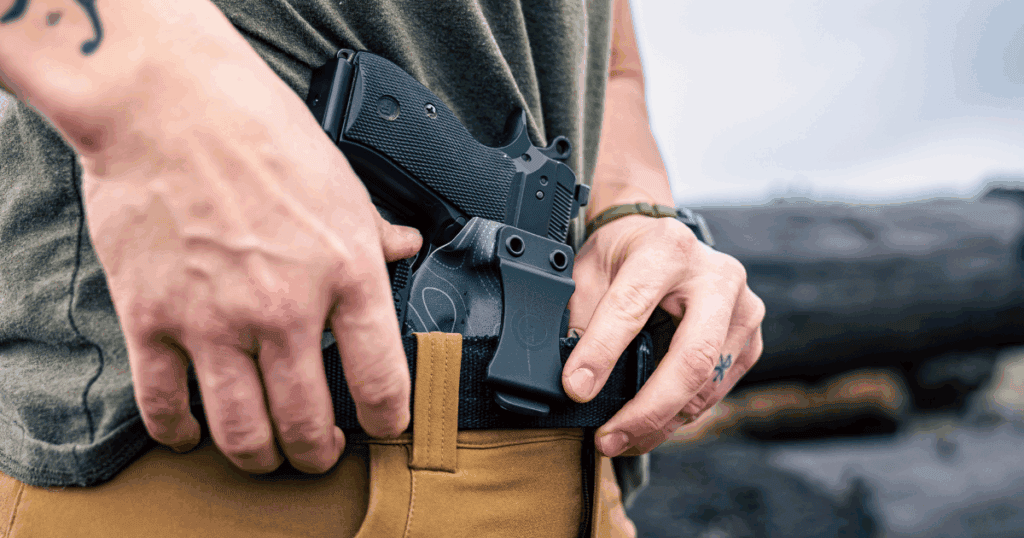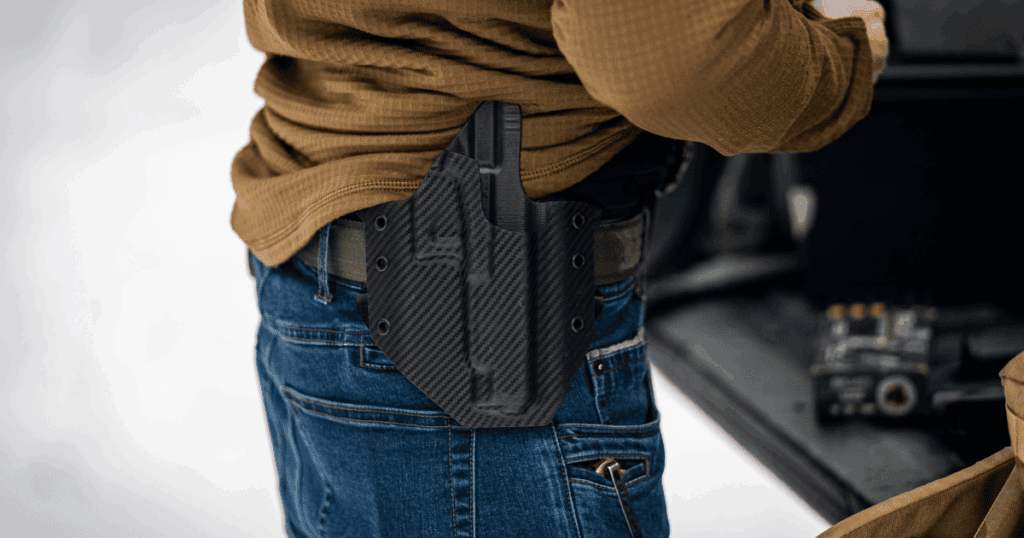A holster isn’t just a nice-to-have if you’re a first-time gun owner. It’s a must-have safety tool. Holsters are part of your everyday carry essentials, right up there with your firearm itself. Choosing the right one early on helps you stay safe, stay in control, and carry with confidence.
Holsters Are More Than Just a Way to Carry
A good holster does three critical things:
- Protects the trigger: Most accidental discharges happen when something (like clothing, keys, or even your hand) gets inside the trigger guard. A solid holster covers the trigger completely, keeping your gun from firing until you want it to.
- Provides retention: Retention means the gun stays put. Whether walking, bending over, or running to your truck in the rain, your holster should hold your firearm securely until you decide to draw it.
- Supports safe, consistent draws: Drawing a firearm takes practice. A stable, well-fitted holster gives you the same feel and position every time, building muscle memory and helping you move safely under stress.
Holsters Are Core Gun Safety Gear
Along with safe storage and basic handling rules, a good holster is part of your gun safety gear. It helps prevent accidents at home, at the range, or while out and about.
This kind of protection isn’t optional. It’s the foundation of carrying responsibly.
Understanding Holster Types: What Are Your Carry Options?
As a first-time gun owner, one of the first choices you’ll face is how to carry. Holsters come in a range of styles, but not all are beginner-friendly. Let’s break down the most common types and help you decide where to start.
IWB vs. OWB: The Two Most Popular Styles
Most new gun owners end up choosing either IWB (inside-the-waistband) or OWB (outside-the-waistband) holsters. Here’s what each one offers:
IWB (Inside-the-Waistband)
This holster tucks between your body and your pants. It’s great for concealed carry because your gun stays hidden under a shirt or hoodie.
- Pros: Easier to conceal, close to the body, stable
- Considerations: Can feel snug or take getting used to, especially when sitting
OWB (Outside-the-Waistband)
This holster sits outside your waistband, usually attached to a sturdy belt.
- Pros: Easier to access, more comfortable for all-day wear, especially with a jacket or during range practice
- Considerations: Less discreet, more visible unless you’re wearing a longer shirt or coat
If you’re unsure where to start, try an IWB holster for concealed carry and an OWB holster for range days and practice.
Shoulder, Chest, and Specialty Setups
You might also come across shoulder holsters, chest holsters, or ankle and bag holsters. These have specific uses:
- Shoulder holsters: Worn under a jacket, often used for larger firearms or by those sitting for long periods (like in a vehicle).
- Chest holsters: Great for outdoor activities like hiking, running, or riding ATVs.
- Specialty options: Ankle holsters, belly bands, or purse holsters can work for certain situations, but they require more training and aren’t ideal for beginners.
But for your first holster, keep it simple. Start with a well-made IWB or OWB holster that’s easy to use, comfortable to wear, and designed for your specific firearm. You can explore other styles once you’ve built confidence with the basics.
What Makes a Holster Beginner-Friendly?

Not every holster is built with first-time gun owners in mind. Here’s what to look for:
Passive Retention
Passive retention means your holster holds the gun in place with its shape and not with buttons, straps, or snaps. The holster is molded to fit your specific firearm and “clicks” into place when you insert the gun.
- You can draw quickly and reholster easily.
- There’s no need to fumble with release mechanisms.
- Less to learn = safer carry for beginners.
For more information, read Your Definitive Guide to Holster Retention.
Trigger Guard Coverage
A good holster should completely cover the trigger and trigger guard – there should be no gaps or wiggle room. This is one of the most critical safety features for new carriers.
Look closely at the holster’s shape. If you can see or touch the trigger when your gun is holstered, it’s not safe to carry.
Belt Clip
If it’s hard to put on, you won’t wear it. Beginner-friendly holsters need a secure, easy-to-use belt clip.
- Slides easily onto your belt with no threading or fuss.
- It stays locked in place until you take it off.
- Makes it quicker to get ready in the morning.
Adjustable Cant and Ride Height
Not every body or body position is the same. A good starter holster lets you adjust:
- Cant (the angle of the gun), and
- Ride height (how high or low it sits).
This matters more than you think. A small tweak can make a huge difference in comfort, concealment, and draw access. Adjusting things helps you fine-tune your setup without needing to buy a new holster every time your needs change.
Reholstering and Comfort
When you reholster, your gun is live and your hand is close to the trigger. A poorly designed or flimsy holster can bend, collapse, or shift – turning a simple task into a safety risk.
This is where rigid materials like Kydex shine. They keep their form, even after long hours of wear, making it easier and safer to reholster on the move. You might think hard plastic sounds uncomfortable, but Kydex is one of the best materials for daily carry. Here’s why:
- It’s thin and low-profile, so it doesn’t bulk up your waistband.
- It won’t soak up sweat like soft materials, which helps keep things dry.
- It’s lightweight and molds perfectly to your gun.
Because the best holster isn’t just the one that fits your gun. It’s the one you’ll actually wear.
Why GunfightersINC Holsters Are Ideal for First-Time Gun Owners

The gear you choose can make or break your experience when you’re new to carrying. GunfightersINC takes the guesswork out of it with holsters built for real-world use, not just shelf appeal.
Every design puts safety, simplicity, and comfort front and center, exactly what first-time gun owners need.
Built Right, Right Here in the USA
GunfightersINC holsters are handcrafted by veterans in the U.S. using durable, lightweight Kydex. This material holds its shape, protects your trigger, and keeps your firearm exactly where it belongs.
Every component (from the Kydex to the hardware) is 100% sourced in the U.S. You’re getting clean, solid construction built by people who know what reliable gear means because they’ve depended on it themselves.
Simple Designs That Work for Everyday Carry
If you’re new to concealed carry or just starting to build your gear setup, complicated holsters with extra straps or gimmicks are the last thing you need. GunfightersINC holsters are:
- Easy to put on and take off
- Comfortable for all-day wear
- Built to stay out of your way, but ready when you need it
There is no learning curve, no complicated mechanisms, just smart, beginner-friendly designs made to help you carry with confidence.
Made to Fit Your Firearm
Unlike generic holsters that try to fit every gun (and end up fitting none), GunfightersINC holsters are form-fitted to specific models. That means:
- Solid passive retention right out of the box
- Full trigger guard coverage for safety
- A draw and reholster motion that feels natural and repeatable
You get a snug, secure fit whether carrying a compact semi-auto or a full-size revolver.
Carry Options That Fit Your Life
No two people carry the same way, and that’s why GunfightersINC offers a range of holsters tailored to real-world use.
Here are a few solid starting points:
Solace IWB Holster – A slim, inside-the-waistband holster that’s ideal for concealed carry. Lightweight, comfortable, and easy to clip on and go.
Wraith IWB Holster – Offers more coverage and stability than typical minimalist holsters. It’s molded for your exact firearm and built to stay put throughout the day.
Ronin OWB Holster – A rock-solid outside-the-waistband option for open carry or range use. Rides close to the body with excellent retention and quick access.
Start simple. Master safe carry, draw, and reholstering with a quality IWB or OWB holster that fits your firearm. Once you’ve become comfortable with basic carry, you can explore specialty setups that fit specific lifestyles, like the Kenai Chest Holster or Spectre Shoulder Holster.
Start with Confidence
If you’re new to carrying, the right holster makes all the difference. Look for one that offers safe trigger coverage, solid retention, comfortable wear, and a secure fit for your specific firearm. These aren’t just features. They help you carry with confidence every day.
August 11, 2025
